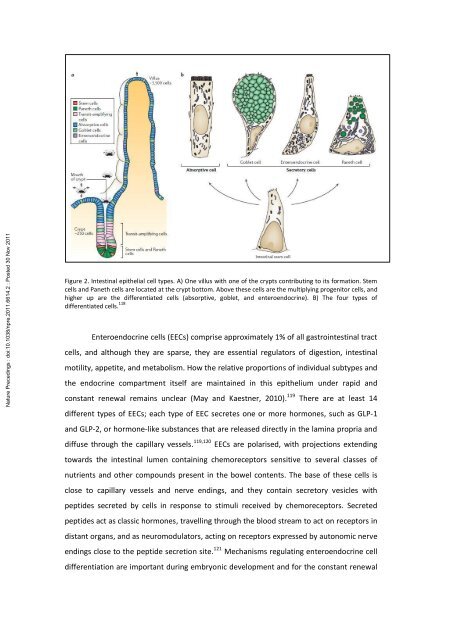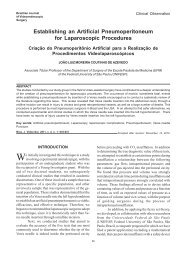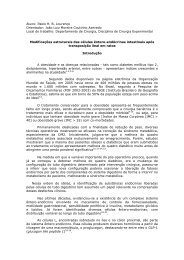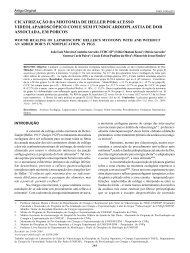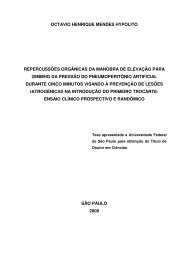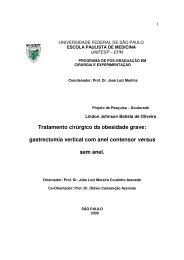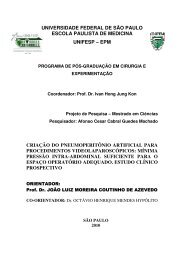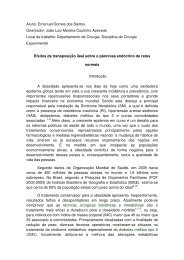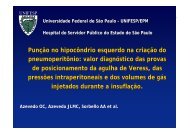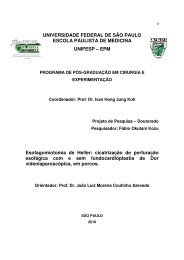Isolated ileal interposition in enteroendocrine L cells differentiation
Isolated ileal interposition in enteroendocrine L cells differentiation
Isolated ileal interposition in enteroendocrine L cells differentiation
You also want an ePaper? Increase the reach of your titles
YUMPU automatically turns print PDFs into web optimized ePapers that Google loves.
Nature Preced<strong>in</strong>gs : doi:10.1038/npre.2011.6614.2 : Posted 30 Nov 2011<br />
Figure 2. Intest<strong>in</strong>al epithelial cell types. A) One villus with one of the crypts contribut<strong>in</strong>g to its formation. Stem<br />
<strong>cells</strong> and Paneth <strong>cells</strong> are located at the crypt bottom. Above these <strong>cells</strong> are the multiply<strong>in</strong>g progenitor <strong>cells</strong>, and<br />
higher up are the differentiated <strong>cells</strong> (absorptive, goblet, and enteroendocr<strong>in</strong>e). B) The four types of<br />
differentiated <strong>cells</strong>. 118<br />
Enteroendocr<strong>in</strong>e <strong>cells</strong> (EECs) comprise approximately 1% of all gastro<strong>in</strong>test<strong>in</strong>al tract<br />
<strong>cells</strong>, and although they are sparse, they are essential regulators of digestion, <strong>in</strong>test<strong>in</strong>al<br />
motility, appetite, and metabolism. How the relative proportions of <strong>in</strong>dividual subtypes and<br />
the endocr<strong>in</strong>e compartment itself are ma<strong>in</strong>ta<strong>in</strong>ed <strong>in</strong> this epithelium under rapid and<br />
constant renewal rema<strong>in</strong>s unclear (May and Kaestner, 2010). 119 There are at least 14<br />
different types of EECs; each type of EEC secretes one or more hormones, such as GLP-1<br />
and GLP-2, or hormone-like substances that are released directly <strong>in</strong> the lam<strong>in</strong>a propria and<br />
diffuse through the capillary vessels. 119,120 EECs are polarised, with projections extend<strong>in</strong>g<br />
towards the <strong>in</strong>test<strong>in</strong>al lumen conta<strong>in</strong><strong>in</strong>g chemoreceptors sensitive to several classes of<br />
nutrients and other compounds present <strong>in</strong> the bowel contents. The base of these <strong>cells</strong> is<br />
close to capillary vessels and nerve end<strong>in</strong>gs, and they conta<strong>in</strong> secretory vesicles with<br />
peptides secreted by <strong>cells</strong> <strong>in</strong> response to stimuli received by chemoreceptors. Secreted<br />
peptides act as classic hormones, travell<strong>in</strong>g through the blood stream to act on receptors <strong>in</strong><br />
distant organs, and as neuromodulators, act<strong>in</strong>g on receptors expressed by autonomic nerve<br />
end<strong>in</strong>gs close to the peptide secretion site. 121 Mechanisms regulat<strong>in</strong>g enteroendocr<strong>in</strong>e cell<br />
<strong>differentiation</strong> are important dur<strong>in</strong>g embryonic development and for the constant renewal


